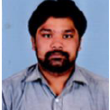
Kama Ramudu
Work place: Dept. of Electronics and Communication Engineering, Kakatiya Institute of Technology and Science, Warangal, Telangana, India
E-mail: ramudukama@gmail.com
Website: https://orcid.org/0000-0002-8585-9396
Research Interests: Image Processing, Image Manipulation, Image Compression
Biography
Dr.Kama Ramudu, received his Bachelor of Engineering degree in Electronics & Communications from V.R.Sidhartha Engineering College, Vijayawada, Acharya Nagarjuna University, Guntur. He obtained his M.Tech in Digital Communication Engineering from Kakatiya Institute of Technology and Science, Warangal, Kakatiya University, Warangal. He obtained his doctor of Philosophy (PhD) in Electronics and Communication Engineering (ECE) from Acharya Nagarjuna University, Guntur, Andhra Pradesh, India. Currently he is Associate Professor in the department of ECE at Kakatiya Institute of Technology and Science, Warangal, Telangana, INDIA. His Research Interest is Biomedical Image Processing and he published 30 International Journals and Conference till date in the field of Image Processing. He is a Member of IETE, and ISTE.
Author Articles
Level Set Segmentation of Images using Block Matching Local SVD Operator based Sparsity and TV Regularization
By Kama Ramudu Gajula Laxmi Bhavani Manabolu Nishanth Akula Prakash Raj Vamshika Analdas
DOI: https://doi.org/10.5815/ijigsp.2023.02.05, Pub. Date: 8 Apr. 2023
Image segmentation is one of the most important steps in computer vision and image processing. Image segmentation is dividing the image into meaningful regions based on similarity pixels. We propose a new segmentation algorithm based on de-noising of images, good segmentation results depends on the noisy free images. This means that, we may not get the proper segmentation results in the presence of noise. For this, image pre-processing stage is necessary to denoise the image. An image segmentation result depends on the pre-processing results. In this paper, proposed a new integrating approach based on de-noising and segmentation which is called Level Set Segmentation of Images using Block Matching Local SVD Operator Based Sparsity and TV Regularization (BMLSVD-TV). The proposed method is dividing into two stages, in the first stage images are de-noised based on BMLSVDTV algorithm. De-noising images is a crucial aspect of image processing, there are a few factors to keep in mind during image de-noising such as smoothing the flat areas, safeguarding the edges without blurring, and keeping the textures and new artifacts should not be created. Block Matching, Updating of basis vector, Sparsity regularization, and TV regularization. This method searches for blocks that are comparable to each other in block matching. The data in the array demonstrates a high level of correlation after the matching blocks are grouped together. The sparse coefficients will be gathered after adequate modification. Most of the noise in the image will be minimized through the sparsity regularization step by employing different de-noising algorithms such as Block matching 3D using fixed basis vectors. The edge information will be retained and the piecewise smoothness of the image will be produced using the TV regularization step. Later, in the second state create a contour on the de-noised image and evolve the contour based on level Set function (LSF) defined. This combined approach gives better performance for segmenting the image regions over existing level set methods. When compared our proposed level set method over state of art level set methods. The proposed segmentation method is superior in terms of no.of iterations, CPU time and area covered over the existing level set methods. By this model, we obtained a good quality of restored image from noisy image and the performance of the image quality assessed by the two important parameters such as PSNR and Mean Square Error (MSE). The higher value of PSNR and lower value of MSE leads to good quality of image. In this research work, the proposed denoising method got higher PSNR values over existing methods. Where recovering the original image content is essential for effective performance, image denoising is a key component. It is used in a variety of applications, including image restoration, visual tracking, image registration, image segmentation, and image classification. This model is the best segmentation method for accurate segmentation of objects based on denoising images when compared with the other models in the field.
[...] Read more.Other Articles
Subscribe to receive issue release notifications and newsletters from MECS Press journals